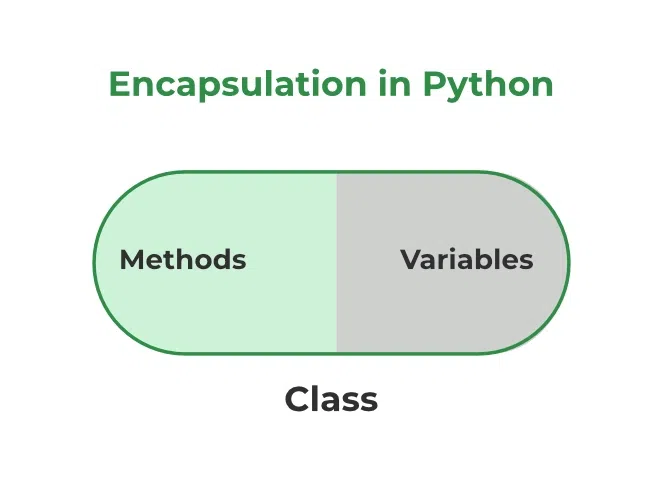Encapsulation in Python
Last Updated :
01 May, 2023
Encapsulation is one of the fundamental concepts in object-oriented programming (OOP). It describes the idea of wrapping data and the methods that work on data within one unit. This puts restrictions on accessing variables and methods directly and can prevent the accidental modification of data. To prevent accidental change, an object’s variable can only be changed by an object’s method. Those types of variables are known as private variables.
A class is an example of encapsulation as it encapsulates all the data that is member functions, variables, etc. The goal of information hiding is to ensure that an object’s state is always valid by controlling access to attributes that are hidden from the outside world.

Encapsulation Python
Consider a real-life example of encapsulation, in a company, there are different sections like the accounts section, finance section, sales section etc. The finance section handles all the financial transactions and keeps records of all the data related to finance. Similarly, the sales section handles all the sales-related activities and keeps records of all the sales. Now there may arise a situation when due to some reason an official from the finance section needs all the data about sales in a particular month. In this case, he is not allowed to directly access the data of the sales section. He will first have to contact some other officer in the sales section and then request him to give the particular data. This is what encapsulation is. Here the data of the sales section and the employees that can manipulate them are wrapped under a single name “sales section”. Using encapsulation also hides the data. In this example, the data of the sections like sales, finance, or accounts are hidden from any other section.
Protected members
Protected members (in C++ and JAVA) are those members of the class that cannot be accessed outside the class but can be accessed from within the class and its subclasses. To accomplish this in Python, just follow the convention by prefixing the name of the member by a single underscore “_”.
Although the protected variable can be accessed out of the class as well as in the derived class (modified too in derived class), it is customary(convention not a rule) to not access the protected out the class body.
Note: The __init__ method is a constructor and runs as soon as an object of a class is instantiated.
Python3
class Base:
def __init__(self):
self._a = 2
class Derived(Base):
def __init__(self):
Base.__init__(self)
print("Calling protected member of base class: ",
self._a)
self._a = 3
print("Calling modified protected member outside class: ",
self._a)
obj1 = Derived()
obj2 = Base()
print("Accessing protected member of obj1: ", obj1._a)
print("Accessing protected member of obj2: ", obj2._a)
|
Output:
Calling protected member of base class: 2
Calling modified protected member outside class: 3
Accessing protected member of obj1: 3
Accessing protected member of obj2: 2
Private members
Private members are similar to protected members, the difference is that the class members declared private should neither be accessed outside the class nor by any base class. In Python, there is no existence of Private instance variables that cannot be accessed except inside a class.
However, to define a private member prefix the member name with double underscore “__”.
Note: Python’s private and protected members can be accessed outside the class through python name mangling.
Python3
class Base:
def __init__(self):
self.a = "GeeksforGeeks"
self.__c = "GeeksforGeeks"
class Derived(Base):
def __init__(self):
Base.__init__(self)
print("Calling private member of base class: ")
print(self.__c)
obj1 = Base()
print(obj1.a)
|
Output:
GeeksforGeeks
Traceback (most recent call last):
File "/home/f4905b43bfcf29567e360c709d3c52bd.py", line 25, in <module>
print(obj1.c)
AttributeError: 'Base' object has no attribute 'c'
Traceback (most recent call last):
File "/home/4d97a4efe3ea68e55f48f1e7c7ed39cf.py", line 27, in <module>
obj2 = Derived()
File "/home/4d97a4efe3ea68e55f48f1e7c7ed39cf.py", line 20, in __init__
print(self.__c)
AttributeError: 'Derived' object has no attribute '_Derived__c'
Share your thoughts in the comments
Please Login to comment...